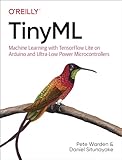TinyML : machine learning with TensorFlow Lite on Arduino and ultra-low-power microcontrollers / Pete Warden and Daniel Situnayake.
Material type: TextPublisher: Beijing Boston : O'Reilly, 2020Edition: First editionDescription: xvi, 484p.: ill.: 23cm illustrations ; 24 cmContent type:
TextPublisher: Beijing Boston : O'Reilly, 2020Edition: First editionDescription: xvi, 484p.: ill.: 23cm illustrations ; 24 cmContent type: - text
- unmediated
- volume
- 9781492052043
- 006.31 WAR 23
- Q325.5 .W37 2020
| Item type | Current library | Collection | Call number | Status | Notes | Date due | Barcode | |
|---|---|---|---|---|---|---|---|---|
| Reference Book | VIT-AP Reference | Reference | 006.31 WAR (Browse shelf(Opens below)) | Not For Loan | CSE | 023669 | ||
| Text Book | VIT-AP General Stacks | 006.31 WAR (Browse shelf(Opens below)) | Checked out to SIVADETH P S (23BCE8273) | CSE | 2025-05-21 | 023670 |
Includes index.
Introduction -- Getting started -- Getting up to speed on machine learning -- The "Hello world" of TinyML : building and training a model -- The "Hello world" of TinyML : building an application -- The "Hello world" of TinyML : deploying to microcontrollers -- Wake-word detection : building an application -- Wake-word detection : training a model -- Person detection : building an application -- Person detection : training a model -- Magic wand : building an application -- Magic wand : training a model -- TensorFlow lite for microcontrollers -- Designing your own TinyML applications -- Optimizing latency -- Optimizing energy usage -- Optimizing model and binary size -- Debugging -- Porting models from TensorFlow to TensorFlow Lite -- Privacy, security, and deployment -- Learning more.
Deep learning networks are getting smaller. Much smaller. The Google Assistant team can detect words with a model just 14 kilobytes in size-- small enough to run on a microcontroller. With this practical book you'll enter the field of TinyML, where deep learning and embedded systems combine to make astounding things possible with tiny devices. Pete Warden and Daniel Situnayake explain how you can train models small enough to fit into any environment. Ideal for software and hardware developers who want to build embedded systems using machine learning, this guide walks you through creating a series of TinyML projects, step-by-step. No machine learning or microcontroller experience is necessary.
There are no comments on this title.

